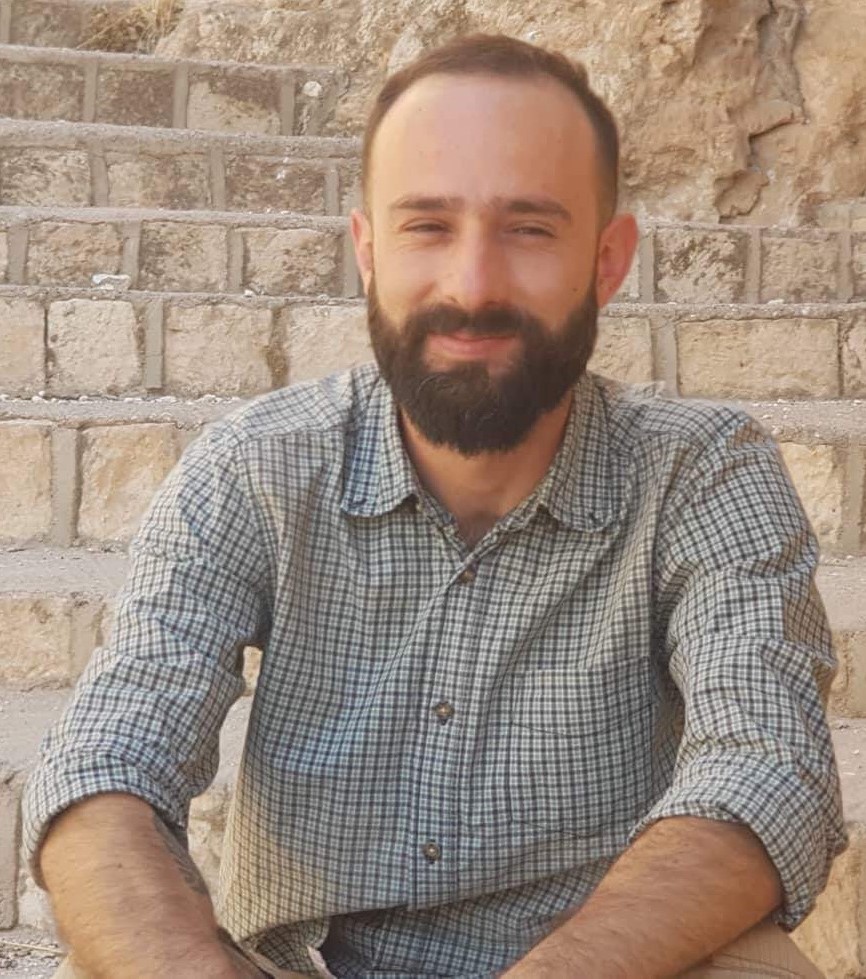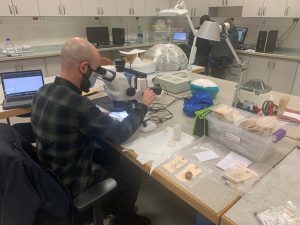
Dr. Moscone, taş alet teknolojisi üzerine uzmanlaşmış bir tarih öncesi arkeoloğudur. Esas olarak silisyumlu hammaddelerin kullanımı ve kesici alet yapım teknikleri ile fikirlerin, tekniklerin ve insanların yayılım ağlarıyla ilgilenmektedir. Neolitik dönemden Tunç Çağı’na kadar çeşitli bağlamlara uzanan ve Akdeniz, Afrika ve Orta Doğu’yu kapsayan uzun bir arazi çalışması tecrübesine sahiptir. 2015’ten beridir Anadolu ve Irak’ta faaliyet gösteren çeşitli arkeolojik kazı ekiplerine taş alet uzmanı olarak katılmaktadır. Doktora derecesini 2020’de İtalya’daki Roma Sapienza Üniversitesi’nden alan Moscone’nin disiplinlerarası tezi, hammadde tedarikinin ötesinde sosyo-ekonomik dinamiklerin incelenmesine dayanmakta ve Geç Kalkolitik Çağ’dan Erken Tunç Çağı’na kadar olan dönemde Irak’ın Kuzeybatı Kürdistan bölgesinde çörtten yapılma büyük kesici aletlerin üretim ve yayılımını mercek altına almaktadır. Moscone, ANAMED’de doktora sonrası araştırma bursiyeri olarak Arslantepe’de (Malatya) çört hammadde tedariki ve kullanımını araştıracaktır. Çalışması, bu yerleşmenin Geç Kalkolitik ve Erken Tunç Çağı evreleri (VII.-VI. dönemleri) boyunca meydana gelen başlıca toplumsal değişimleri göz önünde bulunduran diyakronik bir perspektifi temel alacaktır. Bu yüksek çözünürlüklü sekanstan elde edilen litik buluntu grupları Çört İncelemesi İçin Tahrip Edici Olmayan Çok-Parametreli Protokol (NM-PCI) ile teknolojik yaklaşımı birleştirerek analiz edilecektir.
Research Title: Prehistoric Chert Exploitation, Technology, and Distribution Systems in the Northern Euphrates Basin during the 4th to 3rd Millennia BCE: The Case of Arslantepe (Malatya Plain, Eastern Anatolia)
Dr. Moscone is a prehistoric archaeologist specializing in lithic technology. He is mainly interested in siliceous raw materials exploitation, techniques of blade production, and networks of diffusion of ideas, techniques, goods, and people. He has a long record of fieldwork experience spanning through the Mediterranean, Africa, and the Middle East in contexts dated from the Neolithic to the Bronze Age. Since 2015, he is member, as lithic analyst, of several archaeological expeditions active in Anatolia and Iraq. In 2020, he received his PhD degree at Sapienza University of Rome (Italy) discussing an interdisciplinary thesis based on the study of socio-economic dynamics beyond raw material procurement and large chert blade production and distribution from the Late Chalcolithic to the Early Bronze Age period in the north-western Kurdistan Region of Iraq. As an ANAMED post-doctoral research fellow, he is investigating the procurement and exploitation of chert raw materials at Arslantepe (Malatya). The study is imprinted on a diachronic perspective considering the major social changes that occurred during the Late Chalcolithic and the Early Bronze Age phases at the site (periods VII-VI). The lithic assemblages from this high-resolution sequence are being analyzed by combining the technological approach and a Non-destructive Multi-parametric Protocol for Chert Investigation (NM-PCI).
Fellow’s End of the Academic Year Research Report:
Prehistoric Chert Exploitation, Technology, and Distribution Systems in the Northern Euphrates Basin during the 4th to 3rd Millennia BCE: The Case of Arslantepe (Malatya Plain, Eastern Anatolia)
For the 2021–2022 academic year, I was awarded an ANAMED post-doctoral fellowship to spend 9 months in Istanbul working at Koç University on my research project entitled “Prehistoric Chert Exploitation, Technology, and Distribution Systems in the Northern Euphrates Basin during the 4th to 3rd Millennia BCE: The Case of Arslantepe (Malatya Plain, Eastern Anatolia)”.
But what does it mean to study prehistoric systems of procurement, production, and artifact distribution? How is the researcher’s work conducted (or organized)? First, it is worth mentioning that stone artifacts are cultural, economic, and social markers of choices made by communities from the past. Their ubiquity, durability, and preservation in archaeological contexts make them the preferred artifact category to investigate everyday life and activities of ancient people, alongside pottery.
A wide spectrum of rock types has been used since the beginning of the human journey to accomplish specific tasks: their selection in natural environments, crafting techniques, and use-lives became specialized through time. Furthermore, stone artifacts were never completely abandoned and are still used in traditional contexts today. However, researchers agree on their gradual loss of significance within toolkits beginning with the onset of historical times, especially those produced by chipping. Indeed, chipped stone artifacts in Anatolian archaeology experienced a long history of research, mainly centered around their contribution to the definition of the so-called “Neolithic lifestyle,” which implies the adoption of new crafting techniques, the emergence of specific social figures (e.g., the artisan), and the rise of long-distance communication roads as vectors for the diffusion of ideas, people, and utilitarian goods. If obsidian played a major role in the study of these processes due to the well-known scientific literature surrounding its sources, chert (or flint) raw materials are almost unexplored topics in the Anatolian world. This lack of knowledge becomes evident if recent periods of prehistory are considered: indeed, archaeologists tend to underestimate these tools and to concentrate their efforts on studying much more “informative” objects (!!!).
Nevertheless, the final stages of prehistory can be seen as a sort of apogee of technical and economic specialization regarding chipped stone tools. If, elsewhere in the Mediterranean, the production of bifacial stone daggers represented incontrovertible evidence of artisanal savoir-faire, the Anatolian and Mesopotamian worlds experienced the “big blades production and consumption phenomenon.” As a lithic—and raw materials—analyst, my interest in this topic is twofold: big blades are expressions of crafting identities that center around mining landscapes where generations of artisans learned, through practice and apprenticeship, the “secrets” of specific raw materials; secondly, the specialized character of these productions and their distribution to consumer sites still has a lot to reveal regarding ancient economies. However, without contextualizing the data, all these assumptions are meaningless. The site of Arslantepe is the perfect context to be analyzed because of several factors: its position between diverse geographic and cultural entities; a long archaeological sequence spanning several millennia of history; and, finally, a detailed historical perspective regarding the socio-political events shaping the history of the site.
Coming back to the second question, which deals with the research’s workflow, I’d like to highlight what have been the major steps of the research carried out over the last 9 months at ANAMED. First, thanks to the connections between the Center and the Department of Archaeology and History of Art (ARHA) on the main campus of Koç University, it was possible to establish a collaboration with the ARHA Laboratory aimed at exchanging ideas and expertise during the whole period of my stay in Istanbul. Here, I found an international environment consisting of professors, researchers, and students working on groundbreaking topics and applying the latest cutting-edge technologies and methodologies (Fig. 1).

Fig. 1. Work at the stereomicroscope at the ARHA Lab (Photograph by Rana Özbal).
At the ARHA Laboratory, I worked on the characterization of chert raw materials from selected archaeological samples coming from periods VII (3900–3350 BCE) and VI-A (3350–3000 BCE) of Arslantepe. Two main goals have been pursued: building the data-matrix and implementing the standards of the Non-destructive and Multi-parametric Protocol for Chert Investigations (NM-PCI). The data were collected using a stereomicroscope, a petrographic microscope, a spectrophotometer, and a portable X-Ray Fluorescence instrument. The implementation of the NM-PCI standards has been a fundamental step for the project, as it represented the direct continuation of the work carried out during my doctoral thesis. New variables have been tested and introduced, and the conditions of observation improved, as well.
Apart from the work on the archaeological materials, another important step of the project has been carried out at ANAMED. The goal of this part was to produce a thematic cartography, within a GIS environment, covering the Malatya region and adjacent areas to target chert-bearing geological formations, geomorphology, and hydrology, and preparing for fieldwork to be conducted during the next fieldwork season. All the data have been acquired directly from the General Directorate of Mineral Research and Exploration in Ankara (MTA), thanks to the research budget granted by ANAMED.
Preliminary results from this project have been already presented during the workshop entitled “Large Blades Production and Consumption during Late Prehistory,” co-organized by colleagues from Sapienza University of Rome and myself. However, scientific papers on peer-reviewed international journals are currently planned. Working at ANAMED also meant establishing new collaborations: thanks to the interconnections between the Center, the Netherlands Institute in Turkey (NIT), and ARHA Laboratory, I was able to examinate the raw materials used in the chipped stone assemblages from Barcın Höyük, a Neolithic archaeological site under investigation by the same institutions.
To sum up this experience, I’d like to underline the open-minded and proactive environment I found here, and I would definitely consider Koç University and ANAMED as potential partners for new, exciting projects to develop in the future.
Finally, this project has been strongly supported and encouraged by the Italian Archaeological Mission in Eastern Anatolia (MAIAO) from Sapienza University of Rome, whose long-term archaeological investigations in the Malatya Plain allowed the identification of Arslantepe Höyük as one of the first early-state societies in human history. I am grateful to the Turkish Ministry of Culture and Tourism, the Archaeological Museum of Malatya, and the Arslantepe Research Project, as well, for having granted me all the permissions to safely transport the materials to Istanbul and carry out this study in the best possible conditions.

